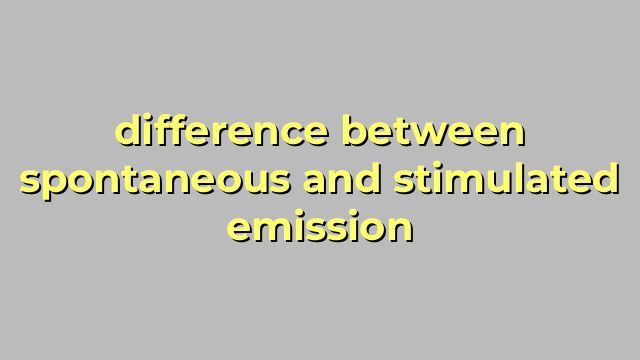The Difference Between Spontaneous and Stimulated Emission
Introduction
Spontaneous and stimulated emission are two different ways that atoms can release energy in the form of light. Understanding the difference between these two processes is crucial for many areas of physics, including laser technology and quantum mechanics.
Spontaneous Emission
Spontaneous emission occurs when an atom releases energy in the form of a photon without any external stimulation. This can happen when an electron in an excited energy state spontaneously returns to a lower energy state, releasing its excess energy as a photon. The wavelength of the photon is determined by the energy difference between the two states, according to the formula E=hf, where E is the energy of the photon, h is Planck’s constant, and f is the frequency of the photon.
The timing and direction of spontaneous emission are completely random, which makes it difficult to create controlled sources of light using this process alone.
Stimulated Emission
Stimulated emission, on the other hand, occurs when an incoming photon interacts with an excited atom, causing it to release a second photon that has the same frequency and direction as the first one. This results in two identical photons traveling in the same direction, which is the process that makes laser technology possible.
To understand stimulated emission, we need to look at the energy levels of the atoms involved. When an excited atom is hit by a photon with energy equal to the energy difference between its excited and ground states, it will be stimulated to release its excess energy in the form of a photon with the same energy and frequency as the incoming photon. This creates a cascade effect, with each new photon stimulating more and more atoms to emit photons, resulting in a coherent beam of light.
Conclusion
In summary, spontaneous emission is a random process that occurs when an excited atom releases energy in the form of a photon, while stimulated emission is a controlled process that happens when incoming photons stimulate excited atoms to release identical photons. Understanding the differences between these two processes is crucial for fields like quantum mechanics and laser technology, which rely on the properties of light and atoms to function properly.
Table difference between spontaneous and stimulated emission
| Characteristic | Spontaneous Emission | Stimulated Emission |
|---|---|---|
| Definition | Process in which an excited electron in an atom or molecule emits a photon without any external prompting. | Process in which an excited electron in an atom or molecule emits a photon due to an external stimulus. |
| Energy Source | Internal energy of the excited electron in the atom or molecule. | External energy source usually in the form of a photon or electromagnetic radiation. |
| Stimulus | No external stimulus is required. | External stimulus is required to cause the emission process. |
| Direction of Emission | Random direction and phase. | Same direction and phase as the stimulating photon or electromagnetic radiation. |
| Amplification | No amplification occurs. | Amplification occurs when stimulated emission occurs in a medium with a population inversion. |

